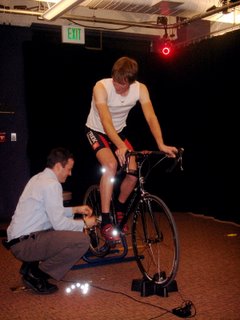Worth Every Penny
Did you know that during a moderate 1 hour bike ride the average cyclist will perform over 3,000 pedal rotations with each leg?
Throw in a bum hip (in my case) and each stroke increases the potential for injury, but small adjustments to seat heights or foot positioning can make a significant difference in preventing injury, eliminating pain and improving performance.

Like I said before, "If I were to spend my hard earned dough on anything bike related, it would be a 3-D bike fit analysis at the Boulder Center for Sports Medicine". Yesterday I had my opportunity and thanks to Todd Carver, Jeff Guerra and Jeremy Rodgers I am feeling like a new man in the saddle.

The 3-D fit analysis stands alone in the bike fit industry because kinematic data can be captured by the system while patients ride their bike on a stationary trainer for 10-15 minutes. During that time, multiple camera views provide the clinician a complete three-dimensional view of the hip, knee, and ankle angles to determine if the patient pronates, internally rotates the knees or has other physical or cycling gait abnormalities.

Evaluation revealed that my right leg was about 15% less efficient then my left, forcing me to compensate with my entire left side... Which explained my constant pains and aches. By the end of the fit, I was completely dialed in on both the road and the mtb and today I feel like a million bucks (thanks to some pedal washers, cleat canting/shimming and multiple changes in my saddle position). I cannot stress enough how important it is to address your position on the bike and find your power zone. Check these guys out, their work is priceless, and they have proven themselves to be the best in the business.
Throw in a bum hip (in my case) and each stroke increases the potential for injury, but small adjustments to seat heights or foot positioning can make a significant difference in preventing injury, eliminating pain and improving performance.

Like I said before, "If I were to spend my hard earned dough on anything bike related, it would be a 3-D bike fit analysis at the Boulder Center for Sports Medicine". Yesterday I had my opportunity and thanks to Todd Carver, Jeff Guerra and Jeremy Rodgers I am feeling like a new man in the saddle.

The 3-D fit analysis stands alone in the bike fit industry because kinematic data can be captured by the system while patients ride their bike on a stationary trainer for 10-15 minutes. During that time, multiple camera views provide the clinician a complete three-dimensional view of the hip, knee, and ankle angles to determine if the patient pronates, internally rotates the knees or has other physical or cycling gait abnormalities.

Evaluation revealed that my right leg was about 15% less efficient then my left, forcing me to compensate with my entire left side... Which explained my constant pains and aches. By the end of the fit, I was completely dialed in on both the road and the mtb and today I feel like a million bucks (thanks to some pedal washers, cleat canting/shimming and multiple changes in my saddle position). I cannot stress enough how important it is to address your position on the bike and find your power zone. Check these guys out, their work is priceless, and they have proven themselves to be the best in the business.


6 Comments:
Thats awesome that you were able to get in there and get on top of things. I am so thrilled that you found such a solid guy like Dr. Rodgers, I have tons of respect for what he is doing out there. Keep up the good work and stay warm.
That is definately the way to get a custom fit. With all of your recent "dirt motivation", why did you choose to have it done on your road bike?
Great blog by the way.
I actually had the fit done on both bikes, the pics were just taken during the road fit...
my friend did the samething and swears by it! btw I have those same shoes ;)
Oh yeah and thanks for the e-mail the race went well! ;)
So can you apply those settings to ANY road/MTB bike you ride?
hey, that is awesome. I just got my cleats positioned on my shoes using this super cool new device at the office. Man were they way off from where they should have been. Hopefully I'll pick up a few more mph. They do your cleats as well?
-Chris
Post a Comment
<< Home